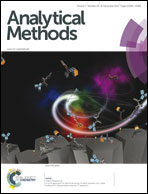Molecularly imprinted polymers prepared using a porogenic solvent of an ionic liquid and a macromolecular crowding agent and their application in purification of oleanic acid†
Abstract
A strategy to increase the affinity of molecularly imprinted polymers (MIPs) using a novel porogenic solvent was described based on the cooperative effect of ionic liquids and macromolecular crowding agents. A typical porogenic solvent is composed of a ternary mixture of polymethylmethacrylate (PMAA) solution in chloroform, dimethyl sulfoxide and 1-butyl-3-methylimidazolium tetrafluoroborate. The method can produce 4-vinylpyridine-based MIP monoliths with good permeability. The influence of some important polymerization variables, i.e., PMMA concentration, the type of ionic liquid and crowding agent, and the ratio between PMMA and the ionic liquid, on the imprinting performance was studied. The cooperative effect of the macromolecular crowding agent and ionic liquid was demonstrated by comparing the imprinting effect of the MIPs with other polymers made with only the macromolecular crowding agent or ionic liquid. The type of macromolecular crowding agent and ionic liquid has significantly influenced the imprinting performance of the achieved MIPs. The resulting oleanic acid (OA) MIP can be used to purify OA from the crude extract efficiently with a mean recovery of 72.32%.


 Please wait while we load your content...
Please wait while we load your content...